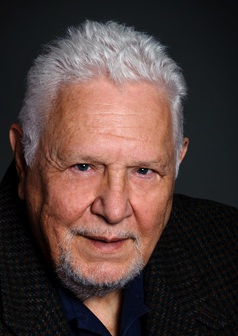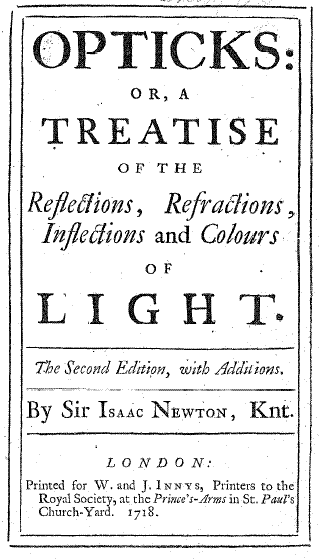Related Research Articles

Sir Isaac Newton was an English polymath active as a mathematician, physicist, astronomer, alchemist, theologian, and author who was described in his time as a natural philosopher. He was a key figure in the Scientific Revolution and the Enlightenment that followed. His pioneering book Philosophiæ Naturalis Principia Mathematica, first published in 1687, consolidated many previous results and established classical mechanics. Newton also made seminal contributions to optics, and shares credit with German mathematician Gottfried Wilhelm Leibniz for developing infinitesimal calculus, though he developed calculus years before Leibniz. He is considered one of the greatest and most influential scientists in history.

Optics is the branch of physics that studies the behaviour and properties of light, including its interactions with matter and the construction of instruments that use or detect it. Optics usually describes the behaviour of visible, ultraviolet, and infrared light. Because light is an electromagnetic wave, other forms of electromagnetic radiation such as X-rays, microwaves, and radio waves exhibit similar properties.

The University of New South Wales (UNSW), also known as UNSW Sydney, is a public research university based in Sydney, New South Wales, Australia. It is one of the founding members of Group of Eight, a coalition of Australian research-intensive universities.

Nader Engheta is an Iranian-American scientist. He has made pioneering contributions to the fields of metamaterials, transformation optics, plasmonic optics, nanophotonics, graphene photonics, nano-materials, nanoscale optics, nano-antennas and miniaturized antennas, physics and reverse-engineering of polarization vision in nature, bio-inspired optical imaging, fractional paradigm in electrodynamics, and electromagnetics and microwaves.

Victor John Stenger was an American particle physicist, philosopher, author, and religious skeptic.
Ian Hugh Sloan AO is an Australian applied mathematician.

Newtonianism is a philosophical and scientific doctrine inspired by the beliefs and methods of natural philosopher Isaac Newton. While Newton's influential contributions were primarily in physics and mathematics, his broad conception of the universe as being governed by rational and understandable laws laid the foundation for many strands of Enlightenment thought. Newtonianism became an influential intellectual program that applied Newton's principles in many avenues of inquiry, laying the groundwork for modern science, in addition to influencing philosophy, political thought and theology.

The Faculty of Science is a constituent body of the University of New South Wales (UNSW), Australia. It is UNSW's second largest Faculty. It has over 400 academic staff and over 700 research staff and students.

Michael Hochberg is an American physicist. He’s authored over 100 peer-reviewed journal articles, has founded several companies, and has been an inventor on over 60 patents. Hochberg's research interests include silicon photonics and large-scale photonic integration. He has worked in a number of application areas, including data communications, biosensing, quantum optics, mid-infrared photonics, optical computing, and machine learning. Much of his work in silicon photonics has been the product of a longstanding series of collaborations with Thomas Baehr-Jones.
Michal Lipson is an American physicist known for her work on silicon photonics. A member of the National Academy of Sciences since 2019, Lipson was named a 2010 MacArthur Fellow for contributions to silicon photonics especially towards enabling GHz silicon active devices. Until 2014, she was the Given Foundation Professor of Engineering at Cornell University in the school of electrical and computer engineering and a member of the Kavli Institute for Nanoscience at Cornell. She is now the Eugene Higgins Professor of Electrical Engineering at Columbia University. In 2009 she co-founded the company PicoLuz, which develops and commercializes silicon nanophotonics technologies. In 2019, she co-founded Voyant Photonics, which develops next generation lidar technology based on silicon photonics. In 2020 Lipson was elected the 2021 vice president of Optica, and serves as the Optica president in 2023.

Ajoy Kumar Ghatak is an Indian physicist and author of physics textbooks.

Benjamin John Eggleton,, is Pro Vice Chancellor (Research) at the University of Sydney. He is also Professor in the School of Physics where he leads a research group in photonics, nanotechnology and smart sensors and serves as co-director of the NSW Smart Sensing Network (NSSN).
Richard Magee Osgood Jr. was an American applied and pure physicist. He was Higgins Professor of Electrical Engineering and Applied Physics at Columbia University.

Gerard James Milburn is an Australian theoretical quantum physicist notable for his work on quantum feedback control, quantum measurements, quantum information, open quantum systems, and Linear optical quantum computing.
John Love was a pioneer in the field of fibre optics, who co-authoring the widely used textbook Optical Waveguide Theory and was Emeritus Professor of guided wave photonics at Australian National University (ANU).

Anurag Sharma is an Indian physicist and a professor at the department of physics of the Indian Institute of Technology Delhi. He is known for his pioneering researches on optoelectronics and optical communications and is an elected fellow of all the three major Indian science academies viz. Indian Academy of Sciences, Indian National Science Academy and National Academy of Sciences, India as well as Indian National Academy of Engineering. The Council of Scientific and Industrial Research, the apex agency of the Government of India for scientific research, awarded him the Shanti Swarup Bhatnagar Prize for Science and Technology, one of the highest Indian science awards for his contributions to Engineering Sciences in 1998.
Halina Rubinsztein-Dunlop is a professor of physics at the University of Queensland and an Officer of the Order of Australia. She has led pioneering research in atom optics, laser micro-manipulation using optical tweezers, laser enhanced ionisation spectroscopy, biophysics and quantum physics.

Boris Yakovlevich Zeldovich (Russian: Бори́с Я́ковлевич Зельдо́вич; 23 April 1944 – 16 December 2018) was a Russian-American physicist and a son of the famous Soviet physicist Yakov Borisovich Zeldovich. He was doctor of the Physical and Mathematical sciences (from 1981) and a corresponding member of the Russian Academy of Sciences. Since 1994 Zeldovich worked as a professor at the College of Optics and Photonics at the University of Central Florida. During his lifetime he received a number of prestigious awards, including the USSR State Prize in 1983 and the Max Born Award in Physical Optics from the Optical Society (OSA) in 1997 for his contributions to the fields of non-linear optics, optical waveguide theory and optical holography. B.Zeldovich predicted and discovered, experimentally, the giant optical nonlinearity of liquid crystals, which is 1010 times stronger than for usual media and is the co-discoverer of optical phase conjugation. He died on 16 December 2018 at the age of 74.

Sergey I. Bozhevolnyi is a Russian-Danish physicist. He is currently a professor and the leader for the Centre for Nano Optics at the University of Southern Denmark.
Arthur Aaron Oliner was an American physicist and electrical engineer, who was professor emeritus at department of electrical and computer engineering at New York University-Polytechnic. Best known for his contributions to engineering electromagnetics and antenna theory, he is regarded as a pioneer of leaky wave theory and leaky wave antennas.
References
- ↑ "British National Bibliography, Pask, Colin, 1943-, The British Library". bnb.data.bl.uk.
- ↑ "Emeritus Professor Colin Pask". research.unsw.edu.au. Retrieved 29 January 2019.
- 1 2 3 "Colin Pask". unsw.adfa.edu.au.
- 1 2 3 4 Journal of the Optical Society of America: Optics and image science. A. The Society. 1986. p. 1106.
- ↑ "Colin Pask - The Mathematics Genealogy Project". genealogy.math.ndsu.nodak.edu.
- ↑ "Colin Pask". Penguin Random House Canada. Retrieved 29 January 2019.
- ↑ McIntyre, P.; Pask, C. (1 February 2013). "The Stiles–Crawford effect: a theoretical revisit". Journal of Modern Optics. 60 (4): 266–283. Bibcode:2013JMOp...60..266M. doi:10.1080/09500340.2013.770575. ISSN 0950-0340. S2CID 121098614.
- ↑ Stavenga, Doekele G.; Hardie, Roger C. (6 December 2012). Facets of Vision. Springer Science & Business Media. p. 40. ISBN 978-3-642-74082-4.
- ↑ Adams, M. J. (1981). An Introduction to Optical Waveguides. Wiley. p. 330. ISBN 978-0-471-27969-3.
- ↑ Pask, Colin (2011). Math for the Frightened: Facing Scary Symbols and Everything Else that Freaks You Out about Mathematics. Prometheus Books. ISBN 978-1-61614-421-0.
- ↑ Pask, Colin (3 September 2013). Magnificent Principia: Exploring Isaac Newton's Masterpiece. Prometheus Books. ISBN 978-1-61614-746-4.
- ↑ Pask, Colin (7 July 2015). Great Calculations: A Surprising Look Behind 50 Scientific Inquiries. Prometheus Books. ISBN 978-1-63388-029-0.